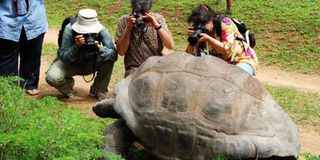Mombasa’s Haller Park is new home for 11 endangered tortoises seized at JKIA

Tourists take pictures of an old tortoise at Haller Park in Mombasa. The park has been granted custody of 11 tortoises of an endangered species which were seized at JKIA, Nairobi in January 2016 while on transit. FILE PHOTO | NATION MEDIA GROUP
What you need to know:
- Haller Park was granted custody of the tortoises after it expressed interest to keep them under conditions prescribed by KWS.
- The park also hosts the Aldabra tortoises (giant tortoises) which are naturally found in Aldabra Island, in the Seychelles.
- They are also listed on Appendix I of Cites as they are mostly preferred for trade as pets.
Haller Park in Mombasa has been granted the custody of 11 tortoises of an endangered species which were rescued at the Jomo Kenyatta International Airport (JKIA) in January 2016 while on transit.
The tortoises were confiscated from illegal traffickers by Kenya Wildlife Service (KWS) officers.
Known as Angonoka or ploughshare (Astrochelys yniphora), the tortoises were in 1986 declared as critically endangered under the International Union for Conservation of Nature (IUCN) red list criteria.
They are also listed on Appendix I of the Convention on International Trade in Endangered Species of Wild Fauna and Flora (Cites) as they are mostly preferred for trade as pets.
Bamburi Lafarge Ecosystems Environmental Education & Ecosystems Manager Albert Musando said Haller Park was granted custody of the tortoises after it expressed interest to keep them under conditions prescribed by KWS.
NOT ALLOWED TO MIX
“This includes the species not being allowed to mix with other indigenous tortoises to avoid hybridisation, as a way of protecting the genetic pool.
“This is in line with Haller Park’s biodiversity conservation programme,” Mr Musando said.
The official said the Angonoka tortioises are not found in Kenya and therefore the only current population are the ones under their care.
“This extremely rare tortoise is [found in] Madagascar. It is thought that only around 600 individuals remain in the wild. These individuals occur in just five isolated and small populations in a 30 kilometre radius of Baly Bay in north western Madagascar,” he said.
Other threats facing the animal include habitat loss as a result of uncontrolled bush fires and predation of eggs and young ones by other animals and humans.
LOW BREEDING POTENTIAL
“They also have a slow growth rate and low breeding potential. In addition, it takes the tortoises a long time to reach sexual maturity.
“All of these factors reduce the capacity of populations to recover from human-induced effects on the population,” Mr Musando said.
Haller Park also hosts the Aldabra tortoises (giant tortoises) which are naturally found in Aldabra Island, in the Seychelles.
There are also hinged back tortoises, leopard tortoises and terrapins, which are all kept for conservation and environmental education.
The park also consists of a game sanctuary, reptile park, a demonstration fish farm, palm garden, crocodile pens and giraffe viewing platforms.
It also has also won the United Nations Environmental Programme Global 500 Roll of Honour award for its unique, ecologically and successful rehabilitation.





